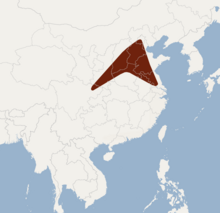Beijing mouse-eared bat
| Beijing mouse-eared bat | |
|---|---|
| Scientific classification | |
| Domain: | Eukaryota |
| Kingdom: | Animalia |
| Phylum: | Chordata |
| Class: | Mammalia |
| Order: | Chiroptera |
| Family: | Vespertilionidae |
| Genus: | Myotis |
| Species: | M. pequinius
|
| Binomial name | |
| Myotis pequinius Thomas, 1908
| |

| |
The Beijing mouse-eared bat, or Peking myotis (Myotis pequinius) is a species of
Taxonomy
It was described as a new species in 1908 by British zoologist Oldfield Thomas. The holotype had been collected by Malcolm Playfair Anderson in 1907. Anderson encountered the species in a cave 30 mi (48 km) west of Beijing.[2]
Description
It is a relatively large mouse-eared bat with a forearm length of 48–50 mm (1.9–2.0 in). Its fur is short and velvety, with the fur on its back a gray, reddish-brown. In contrast, its belly fur is off-white.[3]
Biology and ecology
It is insectivorous, consuming mostly beetles.[4] During the day, individuals roost in caves, though they may also roost in human structures.[1]
Range and habitat
The Beijing mouse-eared bat is endemic to China, where it is found in the provinces of Anhui, Beijing, Henan, Jiangsu, Shanxi, and Sichuan.[1]
Conservation
As of 2019, it is evaluated as a
See also
References
- ^ . Retrieved 14 November 2021.
- ^ Thomas, O. (1908). "The Duke of Bedford's Zoological Exploration in Eastern Asia.-X. List of Mammals from the Provinces of Chih-li and Shan-si, N. China". Proceedings of the Zoological Society of London: 637–638.
- ISBN 978-1400834112.
- .

